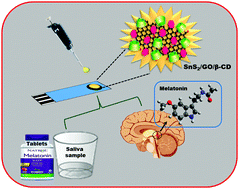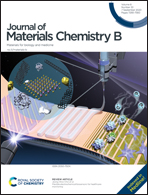Tin disulfide–graphene oxide-β-cyclodextrin mediated electro-oxidation of melatonin hormone: an efficient platform for electrochemical sensing
Abstract
Here, we have developed an electrochemical sensor based on integrated 2D materials including tin disulfide (SnS2) nanoflakes, graphene oxide (GO), and β-cyclodextrin (β-CD) forming a ternary nanocomposite decorated on a screen-printed electrode (SPE) for the electrochemical detection of melatonin. Hydrothermally synthesized SnS2 was mixed with GO/β-CD to prepare the ternary composite via an ultra-sonication process. The nanocomposite was characterized using X-ray diffraction (XRD), field emission scanning electron microscopy (FE-SEM), and field emission transmission electron microscopy (FEG-TEM). The electrochemical performance of the modified electrode was investigated using cyclic voltammetry (CV), electrochemical impedance spectroscopy (EIS), and differential pulse voltammetry (DPV). The electrochemical sensor exhibited a linearity range from 1 nM to 100 μM with the lowest detection limit of 0.17 nM. The sensor was successfully applied for the detection of melatonin in commercial drugs and human saliva, which showed a consistent result with the Enzyme-Linked Immuno-Sorbent Assay (ELISA).



 Please wait while we load your content...
Please wait while we load your content...